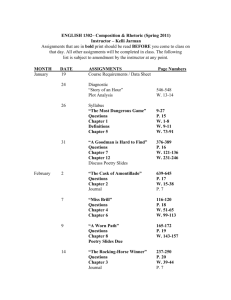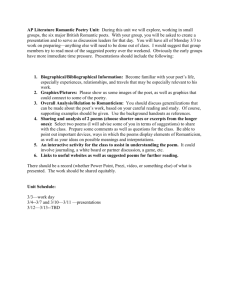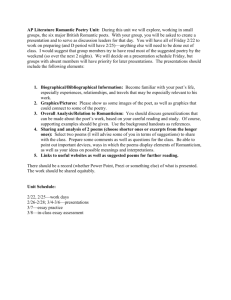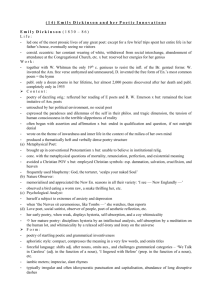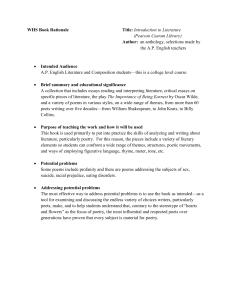I. General Education Review – Writing Course
advertisement
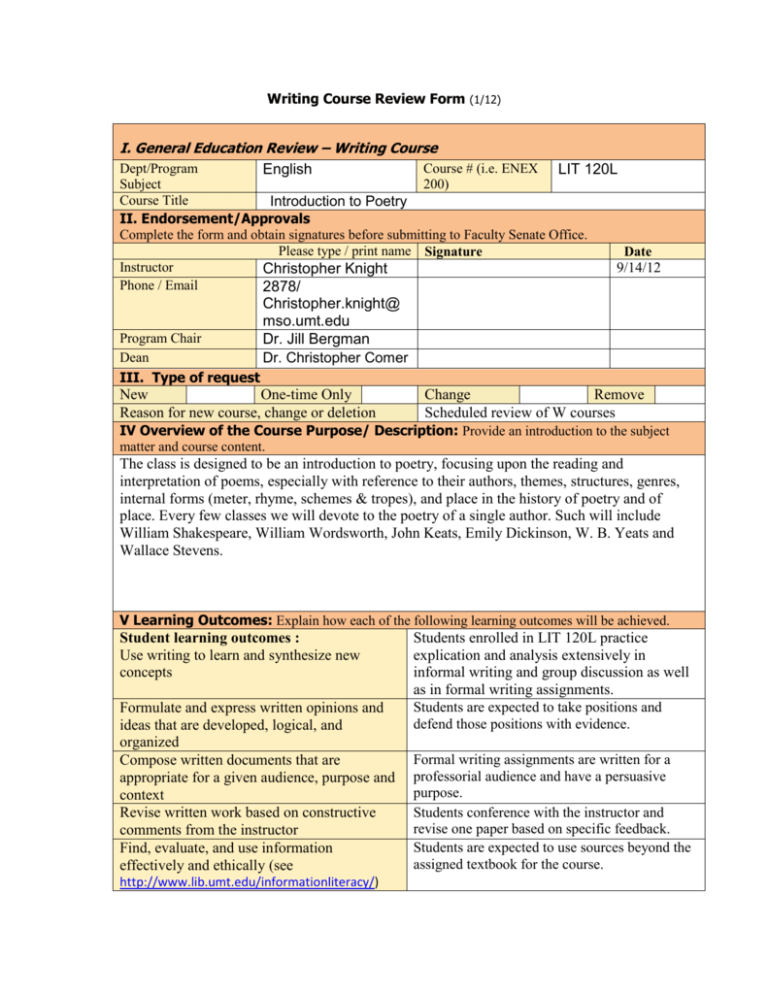
Writing Course Review Form (1/12) I. General Education Review – Writing Course Dept/Program Course # (i.e. ENEX English LIT 120L Subject 200) Course Title Introduction to Poetry II. Endorsement/Approvals Complete the form and obtain signatures before submitting to Faculty Senate Office. Please type / print name Signature Instructor Christopher Knight Phone / Email 2878/ Program Chair Dean III. Type of request Date 9/14/12 Christopher.knight@ mso.umt.edu Dr. Jill Bergman Dr. Christopher Comer New One-time Only Reason for new course, change or deletion Change Remove Scheduled review of W courses IV Overview of the Course Purpose/ Description: Provide an introduction to the subject matter and course content. The class is designed to be an introduction to poetry, focusing upon the reading and interpretation of poems, especially with reference to their authors, themes, structures, genres, internal forms (meter, rhyme, schemes & tropes), and place in the history of poetry and of place. Every few classes we will devote to the poetry of a single author. Such will include William Shakespeare, William Wordsworth, John Keats, Emily Dickinson, W. B. Yeats and Wallace Stevens. V Learning Outcomes: Explain how each of the following learning outcomes will be achieved. Student learning outcomes : Use writing to learn and synthesize new concepts Formulate and express written opinions and ideas that are developed, logical, and organized Compose written documents that are appropriate for a given audience, purpose and context Revise written work based on constructive comments from the instructor Find, evaluate, and use information effectively and ethically (see http://www.lib.umt.edu/informationliteracy/) Students enrolled in LIT 120L practice explication and analysis extensively in informal writing and group discussion as well as in formal writing assignments. Students are expected to take positions and defend those positions with evidence. Formal writing assignments are written for a professorial audience and have a persuasive purpose. Students conference with the instructor and revise one paper based on specific feedback. Students are expected to use sources beyond the assigned textbook for the course. Begin to use discipline-specific writing conventions Demonstrate appropriate English language usage VI. Writing Course Requirements Enrollment is capped at 25 students. If not, list maximum course enrollment. Explain how outcomes will be adequately met for this number of students. Justify the request for variance. What instructional methods will be used to teach students to write for specific audiences, purposes, and genres? Which written assignments will include revision in response to instructor’s feedback? Students are instructed in the conventions of written literary analysis and are expected to follow those conventions. Students are graded on their use of standard, formal English as well as on the content of their written work. Yes Direct instruction in writing. The term paper will require a draft of the first several papers, to be reviewed by the instructor, and subsequently revised by the student. VII. Writing Assignments: Please describe course assignments. Students should be required to individually compose at least 16 pages of writing for assessment. At least 50% of the course grade should be based on students’ performance on writing assignments. Clear expression, quality, and accuracy of content are considered an integral part of the grade on any writing assignment. The grade will be based upon the following: a Formal Graded Assignments term paper (30%), a midterm essay exam (25%), and a final essay examination (25%). and attendance and participation (quiz grades included; also participation in one or more group presentation[s]) (20%). Regarding attendance, you are permitted three absences without penalty; each subsequent absence will result in a subtraction of five points from the twenty points allocated to the participation and attendance portion of your grade (e.g., 20% to 15% for the fourth absence, 15% to 10% for the fifth absence and so forth). The major ungraded assignment will be the draft Informal Ungraded Assignments of the term paper. The instructor will comment upon the draft and suggest ways in which it, as introducing the larger term paper, might well be revised. VIII. Syllabus: Paste syllabus below or attach and send digital copy with form. For assistance on syllabus preparation see: http://teaching.berkeley.edu/bgd/syllabus.html The syllabus must include the following: 1. Writing outcomes 2. Information literacy expectations 3. Detailed requirements for all writing assignments or append writing assignment instructions Paste syllabus here. Prof. Christopher Knight Department of English Office: LA 115; Tel.: 243-2878 Email: Christopher.knight@mso.umt.edu Class Times: MTWR: 9:30-11:20 Classroom: May 21-June 12, DHC 117 June 13-21 (to be announced) Office Hours: Tuesday, 8:30-9:20; & by appointment Summer 2013 LIT 120L: Introduction to Poetry Text: Hunter, J. Paul, Alison Booth and Kelly J. Mays. The Norton Introduction to Poetry. 9th edn. New York: W. W. Norton & Company. Hacker, Diana. A Pocket Style Manual. 4th edn. Boston & New York: Bedford/St. Martin’s. Plan: The class is designed to be an introduction to poetry, focusing upon the reading and interpretation of poems, especially with reference to their authors, themes, structures, genres, internal forms (meter, rhyme, schemes & tropes), and place in the history of poetry and of place. Often, we will devote to the poetry of a single author. Such will include William Shakespeare, William Wordsworth, John Keats, Emily Dickinson, Robert Frost, T. S. Eliot, W. B. Yeats and Wallace Stevens. Also, we will, on occasion, make room for a group-led presentation of a poem. Our schedule of readings is offered below. Please read and think carefully about the poems before that day’s discussion. We will try to stick to schedule, but bear in mind that the schedule is subject to change (additions, subtractions, moving a poem from one day to another and so forth). Schedule of Readings: Week I: 5/21 Speaker (68-92) & Tone (cf. 27-67): Wyatt, “They Flee From Me” 81; Waller, “Song” 188; Pound, “The River-Merchant’s Wife: A Letter” 6; Moore, “Poetry” 276 & 505; Frost, “The Road Not Taken” 542 & “Design” 297; Bradstreet, “To My Dear and Loving Husband” 18; Hughes, “I, Too” 438; & Larkin, “Church Going” 236. 5/22 Speaker (cf. 68-92) & Tone (cf. 27-67): Continued; Situation and Setting (cf. 93-128): Matthew Arnold, “Dover Beach” 104; Tennyson, “Ulysses” 576: Hardy, “Channel Firing” 305, “Neutral Tones” 549, “The Darkling Thrush,” 548; Lowell, “Skunk Hour” 59. 5/23 Situation and Setting (cf. 93-128): Continued. Additional poems: Milton, “When I consider how my light is spent” 266; Anonymous, “The Twenty-third Psalm” 173; Wheatley, “On Being Brought from Africa to America” 415; Hughes, “The Negro Speaks of Rivers” 437 & Blake, “London” 33. 5/24 Poet: William Shakespeare (A29) Week II: 5/29 Poet: Emily Dickinson (A26) 5/30 Description and Image: Pound, “In a Station of the Metro” 567; Williams, “The Red Wheelbarrow” 142, “This Is Just to Say” 143; Swift, “A Description of a City Shower” 118; Jonson, “To Penshurst” 163; Marvell, “On a Drop of Dew” 161; MacLeish, “Ars Poetica” 280 & Williams, “Love: Youth” 155. Group Presentation: Auden, “Musée des Beaux Arts” 295. 5/31 Description and Image: Continued. Additional Poems: Walcott, “Midsummer” 124; Levertov, “Wedding-Ring” 22 & Herrick, “Delight in Disorder” 149. Week III: 6/4 Poet: Robert Frost (A26) 6/5 Poet: William Butler Yeats (A30) 6/6 Poet: T. S. Eliot (A26) 6/7 Poet: Wallace Stevens (A30) Week IV: 6/11 Midterm Examination 6/12 Carpe Diem and Love Poems: Marlow, “The Passionate Shepherd to His Love” 390; Ralegh, “The Nymph’s Reply to the Shepherd” 397; Marvell, “To His Coy Mistress” 106; Donne, “The Flea” 97, “The Canonization” 175; Suckling, “Song” 209; Campion, “When to Her Lute Corinna Sings,” 221; Rosenberg, “Married Love” 7; Moore, “Love in America” 387; Browning, “How Do I Love Thee” 2; Chin, “Summer Love” 110; & Sharon Olds, “Sex Without Love” 139. 6/13 Carpe Diem and Love Poems: Continued. Additional Poems: Anonymous, “Western Wind” 292; Jonson, “Come, my Celia, let us prove” 384 & Herrick, “Upon Julia’s Clothes,” 293. Group Presentation: Donne, “A Valediction: Forbidding Mourning,” 535. 6/14 Poet: William Wordsworth (A30) Week V: 6/18 Language (Metaphor, Simile, Symbol, Tropes, Meter & Rhyme) (cf. 129182): Burns, “A Red, Red Rose” 170; Coleridge, “Metrical Feet” 208; Pope, “Sound and Sense,” 204; Hopkins, “The Windhover” 552; Poe, “The Raven” 212; Shelley, “Ode to the West Wind” 244. Group Presentation: Sylvia Plath, “Daddy” 467 6/19 Poet: John Keats (A28-29) 6/20 Irony & Elegy: Browning, “My Last Duchess” 329; Milton, “Lycidas” 556; Gray, “Elegy Written in a Country Churchyard” 545; Whitman, “When Lilacs in the Dooryard Bloomed” 581; & Auden, “In Memory of Y. B. Yeats” 408. 6/21 Final Examination Requirements: There will be (as noted above) two essay examinations, the first on Monday, June 11th, the second on Thursday, June 21th. There will be no make-ups, except in the most extraordinary circumstances. There will be a ten-page paper due Wednesday, June 20th, preceded by a draft of the paper’s first three or four pages. I will read and comment upon the latter, suggesting avenues for revision. You are welcome to submit the final paper earlier, in which case it will be graded and returned earlier. Late papers will be penalized a full letter grade (e.g., A to B). Participation in class discussions, including participation in group presentations, is expected and attendance is mandatory. You can anticipate spot quizzes upon the readings. Missed quizzes cannot be made up. Your final grade will be based upon the following: 1) each essay exam is worth 25%; 2) the term paper is worth 30%; and 3) your “attendance, participation, and performance upon both quizzes and in-class presentations” is worth a final 20%. Regarding attendance, you are permitted two absences without penalty; each subsequent absence will result in a major subtraction from the twenty points allocated to the third (i.e., “attendance, participation…”) portion of your grade (e.g., 20% to 15% for the third absence, 15% to 10% for the fourth absence, and so on). Late arrivals are frowned upon, and if you need, for good reason, to leave class early, you are asked to notify me at the beginning of the class. University Policy on Academic Honesty: All students must practice academic honesty. Academic misconduct is subject to an academic penalty by the course instructor and/or a disciplinary sanction by the University. All students need to be familiar with the Student Conduct Code. The Code is available for review online at http://www.umt.edu/SA/VPSA/index.cfm/age/1321. Standard Grading Criteria: A Paper: Perhaps the principle characteristic of the A paper is its rich content. Some people describe that content as “meaty,” others as “dense,” still others as “packed.” Whatever, the information delivered is such that one feels significantly taught by the author, sentence after sentence, paragraph after paragraph. The A paper is also marked by stylistic finesse; the title and opening paragraph are engaging; the transitions are artful; the phrasing is tight, fresh, and highly specific; the sentence structure is varied; the tone enhances the purpose of the paper. Finally, the A paper, because of its careful organization and development, imparts a feeling of wholeness and unusual clarity. Not surprisingly, then, it leaves the reader feeling bright, thoroughly satisfied, and eager to reread the piece. B Paper It is significantly more than competent. Besides being almost free of mechanical errors, the B paper delivers substantial information—that is, substantial in both quantity and interest-value. Its specific points are logically ordered, well developed, and unified around a clear organizing principle that is apparent early in the paper. The opening paragraph draws the reader in; the closing paragraph is both conclusive and thematically related to the opening. The transitions between paragraphs are for the most part smooth, the sentence structures pleasingly varied. The direction of the B paper is typically much more concise and precise than that found in the C paper. Occasionally, it even shows distinctiveness—i.e., finesse and memorability. On the whole, then, a B paper makes the reading experience a pleasurable one, for it offers substantial information with few distractions. C Paper It is generally competent—it meets the assignment, has few mechanical errors, and is reasonably well organized and developed. The actual information it delivers, however, seems thin and commonplace. One reason for that impression is that the ideas are typically cast in the form of vague generalities—generalities that prompt the confused reader to ask marginally: “In every case?” “Exactly how large?” “Why?” “But how many?” Stylistically, the C paper has other shortcomings as well: the opening paragraph does little to draw the reader in; the final paragraph offers only a perfunctory wrap-up; the transitions between the paragraphs are bumpy; the sentences, besides being a bit choppy, tend to follow a predictable (hence monotonous) subject-verb-object; and the diction is occasionally marred by unconscious repetitions, redundancy, and imprecision. The C paper, then, while it gets the job done, lacks both imagination and intellectual rigor, and hence does not invite a rereading. D Paper: Its treatment and development of the subject are as yet only rudimentary. While organization is present, it is neither clear nor effective. Sentences are frequently awkward, ambiguous, and marred by serious mechanical errors. Evidence of careful proofreading is scanty, if nonexistent. The whole piece, in fact, often gives the impression of having been conceived and written in haste. E Paper: Its treatment of the subject is superficial; its theme lacks discernible organization; its prose is garbled or stylistically primitive. Mechanical errors are frequent. In short, the ideas, organization, and style fall far below what is acceptable in college writing. Term Paper: In “Dover Bitch” (400), “A Supermarket in California” (543) and “Taking Off Emily Dickinson’s Clothes” (406), the late twentieth-century poets Anthony Hecht, Allen Ginsberg and Billy Collins place themselves in a vexed relation to three of the most distinctive poets of the late nineteenth century: Matthew Arnold (especially in “Dover Beach” [104]), Walt Whitman, and Emily Dickinson. In a ten-page essay, developing a thesis in response to this relation, speak to the point of what the three later poems have in common, analyzing the poems (in light of the host of considerations that we, in our class discussions, have highlighted) not only in relation to one another but also in relation to their nineteenth-century predecessors. That is, take the poems apart, exam them in their particulars, but also be mindful of the influence of history, as it transforms our sense of cultural value. The paper should be typed and double-spaced. Any research that finds itself entering into the paper (as you either quote from someone else’s argument or find yourself influenced by someone else’s thinking) needs to be documented (in the form of a bibliography and footnotes). A draft of the essay’s first three or four pages will be due Monday, June 10th. I will read and comment upon the draft, letting you know whether the paper appears headed in a good direction and suggesting possible revisions. The final paper is due Thursday, June 20th.
